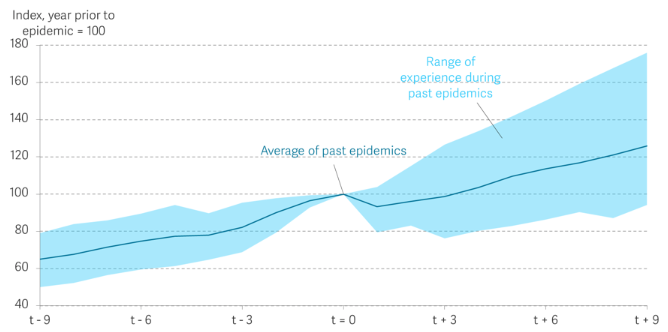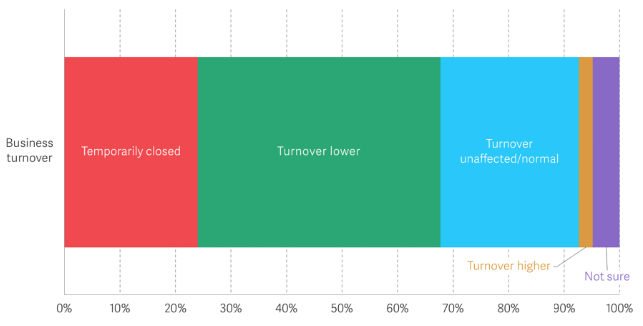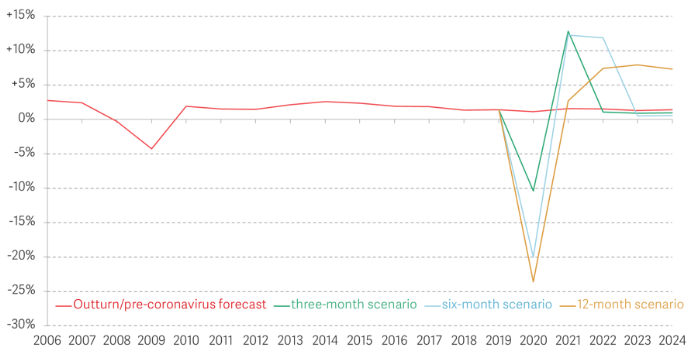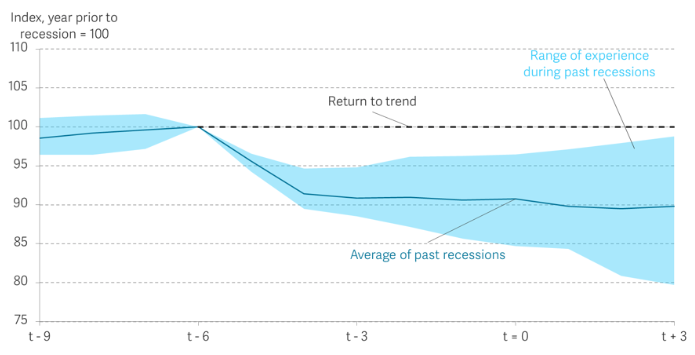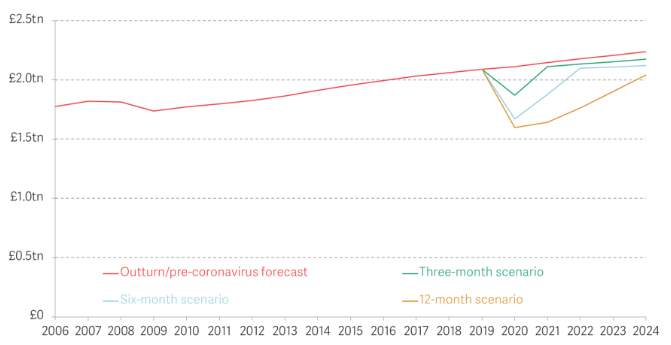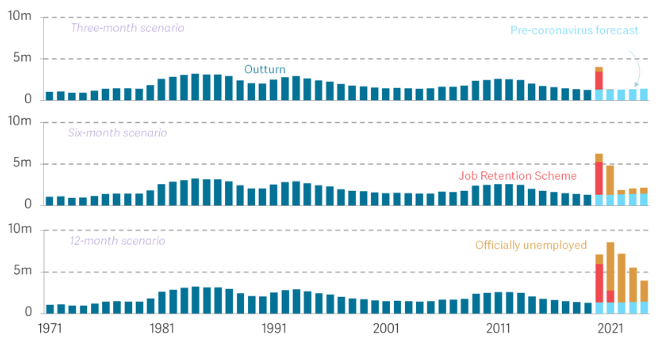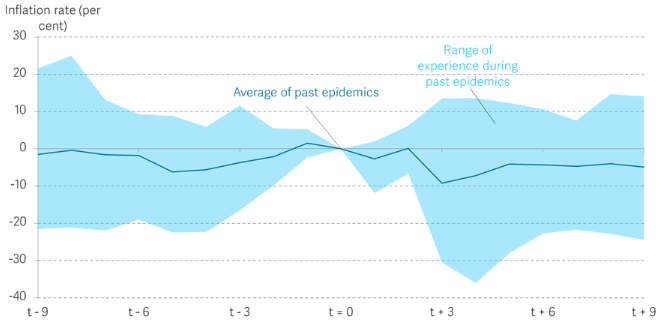The coronavirus pandemic is fundamentally a public health crisis, but it has generated, through necessary social distancing restrictions, an unprecedented shock to the UK and global economy. Understanding the scale, nature and path of the economic shock is important to helping the UK and other governments design fiscal support in a way that reduces the immediate harm to households and firms in the near term, facilitates their recovery over the medium term, and ensures a sustainable exit over the long term.
Drawing on insight from theory, historical experience of previous viral epidemics – such as the 1918 flu pandemic, SARS, and Ebola (Garrett 2007, Siu and Wong 2006, Jordà et al 2020) – and the latest real-time data on the economic activity levels (Adams-Prassl et al. 2020), in this column we outline three potential scenarios for the impact of coronavirus on the UK economy based on social distancing being in place for three, six, and 12 months.
These scenarios are intended to provide economic insights to help government policy development. The scenarios suggest that the economic shock may not only be more severe but also more protracted than many international and national official forecasts have suggested, including those recently published by the IMF (2020), OECD (2020a), and UK Office for Budget Responsibility (2020a).
This has profound implications for the near-term cost and long-term sustainability of government’s fiscal policy responses to the outbreak. In a second VoxEU column, we will explore the fiscal impacts of those three scenarios, taking account of both the direct effect of the economic shock and the cost of the UK government’s fiscal policy response.
Severity of the coronavirus shock
It is too early for official GDP data to be available, which means we have to look elsewhere to understand how far economic activity in the UK is likely to fall as a result of the social distancing measures introduced to stem the spread of coronavirus.
One clue comes from the history of past pandemics. Social distancing restrictions were used as part of the health responses to the 1918-1920 Spanish Flu outbreak in Europe and North America, in Hong Kong during the 2003 SARS outbreak, and West Africa during the 2013-2016 Ebola outbreak. Periods of social distancing during these historic examples varied significantly across and within countries, with restrictions being sequentially tightened and loosened over time (Benmelech and Frydman 2020). The average reduction in economic activity in the year following the outbreak of these previous epidemics was 7%, with falls of 20% experienced by Canada during Spanish Flu and Sierra Leone during Ebola (Hughes 2020), as shown in Figure 1. Given much more widespread use of full economy-wide lockdowns in response to the coronavirus pandemic, this suggests the reductions in GDP during the current outbreak will likely exceed these historic averages.
Figure 1 The level of real GDP in countries following a major viral outbreak (index, year prior to epidemic = 100)
Notes: The chart includes data from Canada, UK and US around the time of the Spanish Flu epidemic (1918); Hong-Kong around the SARS outbreak (2003); and Guinea, Liberia and Sierra Leone during the outbreak of Ebola in 2014. The data are annual and the pre-epidemic peak is taken as t = 0.
Sources: IMF, World Bank, and Jordà et al. (2017).
In the absence of official GDP data, one can also look at range of ad-hoc timely indicators (Leslie and McCurdy 2020) and statistical surveys to estimate the potential reduction in economic activity associated with coronavirus and the resulting lockdown. A new survey of the corporate sector from the UK Office for National Statistics (ONS) suggested that, by mid-April, a quarter of businesses had temporarily closed and a further 40% of firms are experiencing lower turnover. Fewer than 5% of firms are reporting higher turnover than normal (Figure 2). Another survey conducted by a UK business organisation found that three quarters of firms had furloughed at least part of their workforce (British Chambers of Commerce 2020).
Figure 2 Proportion of UK businesses reporting these effects on trading, 6-19 April
Notes: Sample may underestimate firm closure as it only includes responding businesses and excludes permanently closed businesses.
Source: Resolution Foundation analysis of ONS.
Taking this evidence together, a cautious estimate is that UK-wide economic activity may be roughly 30% lower while the current social distancing measures are in place. This top-down estimate is consistent with the bottom-up sectoral-based approaches taken by other researches, such as the OECD (2020a) and French national statistics agency (INSEE). However, there remains significant uncertainty concerning both the strictness and duration the length of time that social distancing measures need to remain in place is probably the largest. Experience from past epidemics suggest that some forms of social distancing restrictions can in place for anywhere from a few months as was the case in East Asian countries during the 2003 SARS outbreak to more than a year, as was the case in West African countries during the 2014-16 Ebola outbreak. In the context of the coronavirus outbreak, the UK chief medical officer stated that, in the absence of a proven vaccine or reliable testing and tracing regime, some disruptive social distancing restrictions will need to be in place in some form for at least a year.
Drawing on this historical and contemporary evidence, we constructed three scenarios for the path of GDP in 2020 depending on whether the lockdown lasts for three, six or 12 months. This gives GDP growth paths set out in Figure 3. In 2020, annual GDP is expected to fall by between 10% and 24%, with a return to positive GDP growth in 2021.
Figure 3 Annual real UK GDP growth: Outturn/pre-coronavirus forecast and three scenarios
Notes: Sample may underestimate firm closure as it only includes responding businesses and excludes permanently closed businesses.
Source: Hughes et al. (2020).
Pace of the economic recovery
The long-run impact of coronavirus on the UK economy and public finances depends not only on the depth of the contraction in output this year, but also how long the economy takes to recover after social distancing restrictions are lifted and how many individuals and firms have been scarred as a result of the downturn. In previous epidemics, it took an average of three years for real GDP to return to its pre-epidemic level. However, while growth seems to return to its previous rate, the lost output during the lockdown was never recovered (Figure 1). The UK’s own experience of recessions suggest that not only is lost output during the typical recession not recovered, but growth rates after those recessions are generally depressed for a number of years after, as shown in Figure 4.
Figure 4 Index of real GDP relative to pre-recession trend around major UK recessions (year prior to recession = 100)
Notes: Includes the 1970s, 1980s, 1990s and financial crisis recessions. Trend is defined as the average growth rate over the five years prior to the start of the recession.
Sources: RF analysis of Bank of England.
Both international and UK experience therefore suggests that a V-shaped recovery is unlikely and that the contraction in GDP in 2020 will have persistent effects. Deteriorating human capital for unemployed workers, loss of labour market connections, damaged firm and household balance sheets, potentially higher demand for precautionary saving post-crisis, and weaker global trade and investment links are all likely to weigh on future growth.
All these effects will be magnified under a longer lockdown meaning the recovery is likely to be slower the longer social distancing restrictions need to be in place. While monetary and fiscal policy measures can and are playing an important role in limiting the scale of the damage, longer lockdowns also increase both the costs and risks associated with these interventions as discussed in Hughes et al. (2020).
The economic scenarios we construct take an optimistic approach and assume that the five-year loss in GDP relative to pre-crisis trend will be roughly equal to the average UK recession in the 12-month scenario. This equates to 7% below the pre-crisis forecast, shown in Figure 5. In the shorter periods of social distancing, the loss in GDP level will be commensurately smaller – 5% and 3%, respectively, for the six- and three-month scenarios.
Figure 5 Real UK GDP: Outturn/pre-coronavirus forecast and scenarios
Notes: The pre-coronavirus forecast is based on the Office for Budget Responsibility’s economic forecast presented at the 2020 Spring Budget. The trough of activity in the 12-month scenario is not double the six-month scenario in 2020 because a quarter of the impact on GDP in the 12-month scenario is in 2021, which shows up in the flatter recovery for that scenario.
Sources: RF analysis of OBR (2020b).
Impact on unemployment
We expect the fall in GDP to have profound and potentially lasting impacts on the labour market. Bowles et al. (2016) found that the fall in employment during the Liberian Ebola outbreak was 24%, with labour-intensive retail and hospitality sectors being particularly hard hit. The total number of workers furloughed in the UK already exceeds 6 million and there have been 2 million new welfare claimants – which together represents more than a quarter of all private sector employees in the UK.
We calculate falls in employment under our three scenarios by combining average historic cyclicality in UK labour productivity with the fall in GDP. The rise in unemployment should be broadly equal to the fall in employment, net of workers using the government’s furlough scheme; we assume no change in labour force participation as it has typically tended to be broadly neutral over the economic cycle, although this was less true for some countries during the Great Recession (Erceg and Levin 2014). This produces the results in Figure 6: annual average unemployment is ‘just’ 1.9 million (5.4%) in 2020 under the three-month scenario but peak annual average unemployment rises to 4.8 million (14.1%) and 7.2 million (20.8%) in the six- and 12-month scenarios, respectively.
Figure 6 Average annual UK unemployment: Outturn, pre-coronavirus forecast and scenarios
Notes: The pre-coronavirus forecast is based on the Office for Budget Responsibility’s economic forecast presented at the 2020 Spring Budget. Unemployment is presented as annual averages.
Sources: RF analysis of OBR (2020b).
Implications for inflation and interest rates
Finally, the path of interest rates and inflation over the coming few years and in the long run are key determinants of the welfare effects and long-term fiscal costs of the outbreak. Theory would suggest that if precautionary savings rise or if labour supply falls (while physical capital remains unaffected), interest rates should fall. This is borne out in empirical evidence form long-run interest rates following previous large-scale pandemics (Jordà et al. 2020). However, the outlook for interest rates in the longer term will depend on expectations for both inflation and the government’s commitment to fiscal sustainability.
Theory is less clear about how inflation may change in the future. Both aggregate supply and demand in the economy have been constrained by social distancing requirements – making it impossible to accurately assess the output gap. Blanchard (2020) argues that the observed increase in savings indicates that disinflation is more likely in the future. This is tentatively supported by the experience of countries in past pandemics where inflation on average was slightly lower post-outbreak (Figure 7). However, if government policy is successful in protecting households and firms from the economic shock, we should expect a bounce-back in pent-up demand temporarily pushing up inflation post-crisis. The scenarios use an agnostic approach and assume inflation would be broadly neutral from 2021 but depressed in 2020.
Figure 7 Consumer price index inflation in countries following a major viral outbreak (percentage point change relative to year prior to the epidemic)
Notes: The chart includes data for Canada, UK and US around the time of the Spanish Flu epidemic (1918); Hong-Kong around the SARS outbreak (2003); and Guinea, Liberia and Sierra Leone during the outbreak of Ebola in 2014. The data is annual and the pre-epidemic peak is taken as t = 0.
Sources: IMF, World Bank, and Jordà et al. (2017).
Concluding remarks
The future rates of inflation and interest rates have important implications not only for the ultimate economic cost of the outbreak but also the sustainability of the government’s fiscal policy response. If interest rates and inflation remain low, the trade-off faced by governments in supporting the economy during this crisis and maintaining long-term fiscal sustainability is much less constraining. However, if interest rates or inflation begin to rise, this could force governments into making more difficult trade-offs between protecting public health, supporting firms and households, and safeguarding the government’s own financial health. We will explore these issues in more depth in our next VoxEU column.
References
Adams-Prassl, A, T Boneva, M Golin, and C Rauh (2020), “Inequality in the Impact of the Coronavirus Shock: Evidence from Real Time Surveys”, IZA DP No. 13183
Benmelech E, and C Frydman (2020), “The 1918 influenza did not kill the US economy”, VoxEU.org, 29 April.
British Chambers of Commerce (2020), “BCC Coronavirus Business Impact Tracker”, 29 April.
Bowles J, J Hjort, T Melvin, and E Werker (2016), “Ebola, jobs and economic activity in Liberia”, Journal of Epidemiology and Community Health 70: 271-277
Erceg C J, and A T Levin (2014), “Labor Force Participation and Monetary Policy in the Wake of the Great Recession”, Journal of Money, Credit and Banking 46(52): 3-49
Garrett T A (2007), “Economic Effects of the 1918 Influenza Pandemic: Implications for a Modern-day Pandemic”, Federal Reserve Bank of St. Louis, November.
Hughes R, J Leslie, C McCurdy, C Pacitti, J Smith, and D Tomlinson (2020), “Doing more of what it takes: Next steps in the economic response to coronavirus”, Resolution Foundation, 16 April.
Hughes R (2020), “Safeguarding governments’ financial health during coronavirus”, Resolution Foundation, 25 March.
Leslie J, and C McCurdy (2020), “The economic effects of coronavirus in the UK; Utilising timely economic indicators”, Resolution Foundation, 30 April.
Jordà Ò, M Schularick, and A M Taylor (2017), “Macrofinancial History and the New Business Cycle Facts”, in NBER Macroeconomics Annual 2016, v. 31, edited by M Eichenbaum and J A Parker, University of Chicago Press
Jordà Ò, S R Singh, and A M Taylor (2020), “The longer-run economic consequences of pandemics”, VoxEU.org, 8 April.
International Monetary Fund (2020), “World Economic Outlook, April 2020: The Great Lockdown”, 6 April.
Office for Budget Responsibility (2020a), “OBR coronavirus reference scenario”, 14 April.
Office for Budget Responsibility (2020b), “Economic and fiscal outlook – March 2020”, 11 March.
Organisation for Economic Co-operation and Development (2020a), “Evaluating the initial impact of COVID-19 containment measures on economic activity”, 14 April.
Organisation for Economic Co-operation and Development (2020b), “Tax and Fiscal Policy in Response to the Coronavirus Crisis: Strengthening Confidence and Resilience”, 15 April.
Siu A, and Y C R Wong (2006), “Economic Impact of SARS: The Case of Hong Kong”, Asian Economic Papers 3(1): 62-83.







